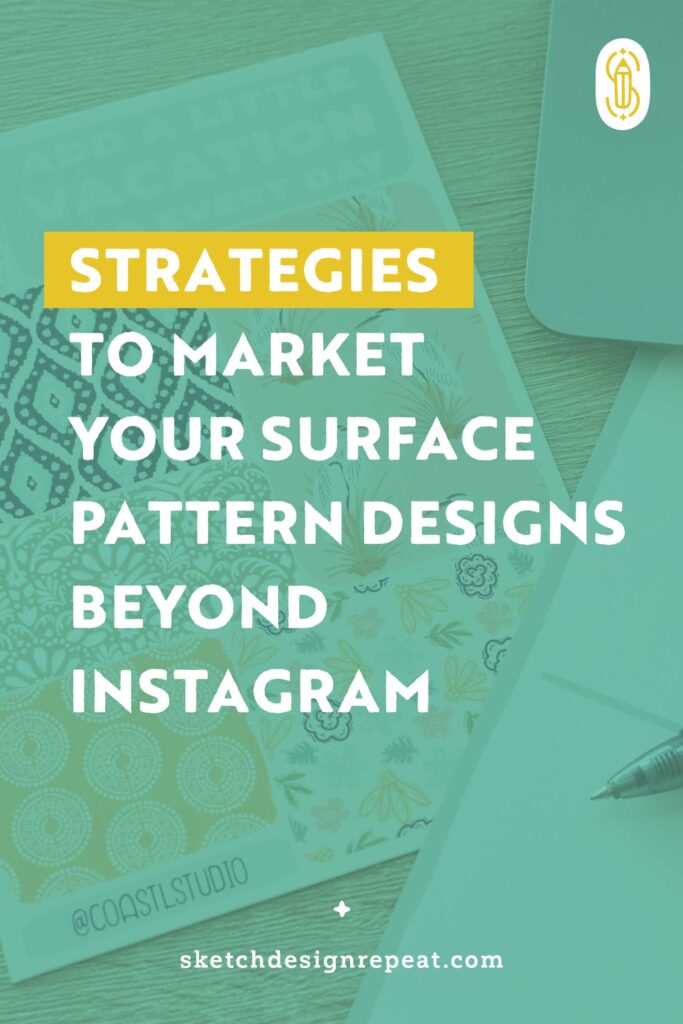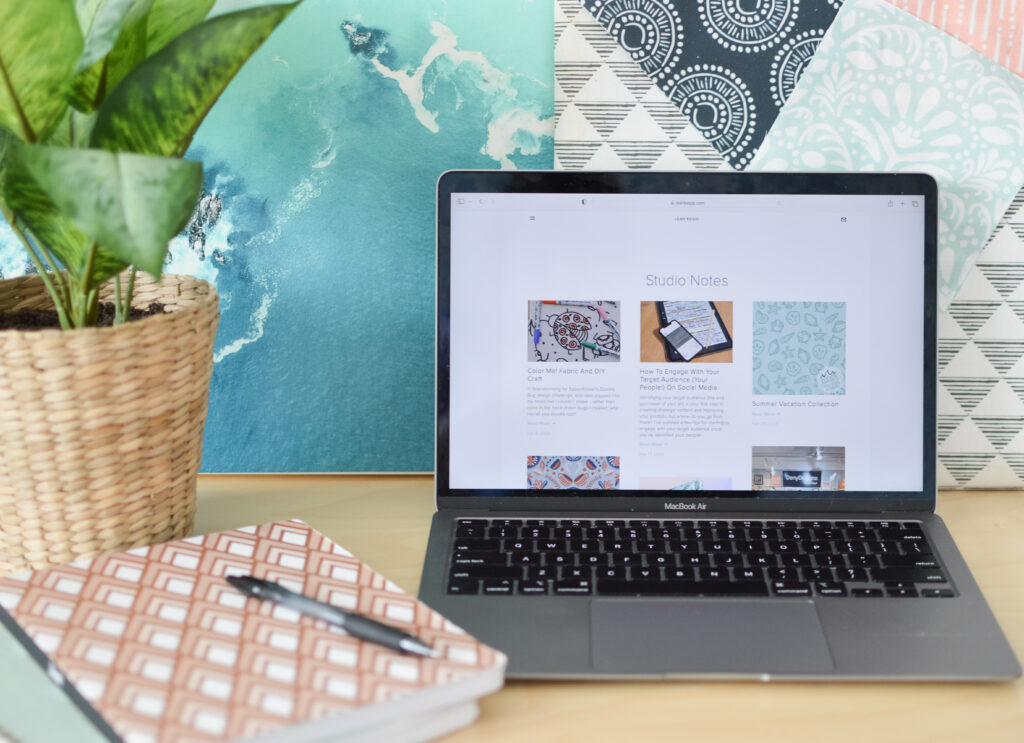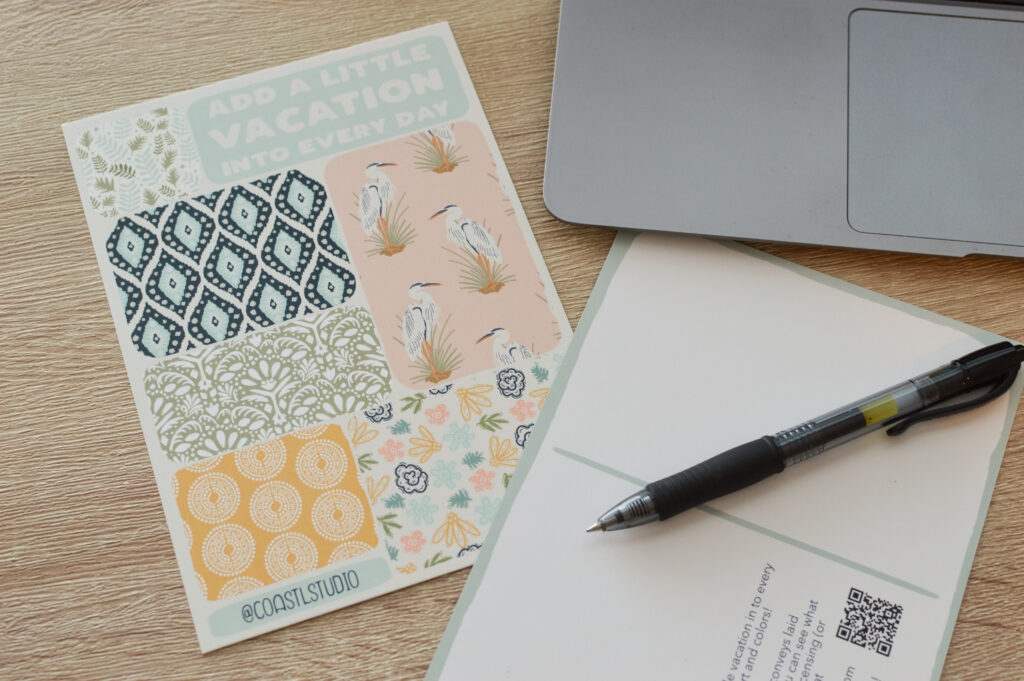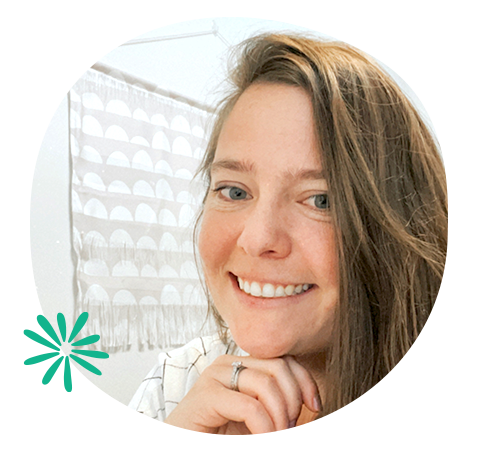Think of marketing like creating a pattern — let’s say you’re making a floral print. You can make a great pattern with a single type of flower, just like you can have a marketing strategy that focuses on one type (or channel) of marketing. But your pattern could be stronger and more dynamic if you incorporated a few more types of flowers.
Social media is a great marketing channel — it’s easy to get started and a great way to connect with the people who will ultimately be buying your art, other artists, and companies who may want to license your art. And the instant gratification of likes and comments is more appealing than waiting for an art buyer to open your email. But it’s not the only way to get your work seen (and when you’re looking to license your art, not always the most effective)!

There are dozens of marketing channels and opportunities to get in front of art buyers and end consumers, but a few stand out for Surface Designers.
Content Marketing
- Benefits: Low cost to start (you probably already have a website!)
- Drawbacks: Content marketing is most effective when it is consistent, so it can take a lot of time — both to create and to see results
The phrase, “Content is King” has been around since January 1996, when Bill Gates correctly predicted that “Content is where I expect much of the real money will be made on the internet.” Content marketing includes (but is certainly not limited to): email newsletters, articles, and even website freebies. The opportunities within content marketing are also more accessible to artists for reaching people who want to buy your art, but these tools can be great for communicating to art directors as well.
There are nuances to each type of content marketing (we’ll get into it) but at the core, the goal in creating any kind of content — this does also apply to social media — is to educate, entertain, and engage the person you’re talking to. This means talking directly to them and providing value through what you’re creating.
Newsletters
This is a different type of email than pitching your artwork — it’s an email sent to an entire contact list. The purpose of a newsletter is to create regular communication with your audience to remind them you exist while creating value. This can be a reminder of art for an upcoming buying season, a collection of currently available prints that fit with an upcoming trend, or sharing a behind the scenes look at your art or process! A quick note: if you’re going to start an email newsletter, plan to do it regularly for it to be effective — at least once a month!
Articles
(Also known as blog posts, or as I call them on my website “Studio Notes.”) I am a huge proponent of having a section of your portfolio website dedicated to a blog type page structure — it’s a great way to share your thoughts, process, AND wins in an organized way. For example, you can capture a current licensing deal on your blog page and use that to demonstrate your work (and support the company you’re working with), as well as encourage people to reach out for available art at the end! You can also show off other ways you’re sharing your art — I created a post about my Live Painting Event I did as part of a partnership, as an example.

Website Freebies
These are often called lead magnets in the marketing world. Basically, you give away something of value to trade for someone’s email address. These are a great piece of stand-alone content or can be part of a strategy to get people signed up for a regular newsletter. Most people think of these kinds of freebies as a connection point to people buying your art, but they can be used for any audience! Specifically, when it comes to connecting with Art Directors, think of “freebies” that benefit them like trend reports, print or pattern organization tools, or something else that is unique to you.
Public Relations
- Benefits: You can start with submissions and do it yourself; it’s fun to have your work in other publications
- Drawbacks: It can take a long time to go from pitching to print; pitching isn’t a guarantee of coverage; quick success can require working with an expert
Public Relations, at its core, is reaching out to companies to see if they want to feature your work (sound familiar?). PR can be a great marketing tool for Surface Pattern Designers, but it can also get pricey… and take a long time to see results. But those results are often great for getting in front of Art Directors. Not sure where to start? Consider submitting designs available for licensing to calls for art from magazines like Uppercase Magazine or submit a collaboration Press Release to Stationery Trends or Gifts and Decor — chances are higher that art directors are perusing for inspiration or trend updates there!
Related Article: Email Pitching Tips from a Former Art Buyer
Direct Mail
- Benefits: You can get in front of buyers directly; more personal but easily replicable to multiple companies
- Drawbacks: Can be costly and time intensive; requires knowing contact and address
Yep, I’m talking about old fashioned snail mail. In a broader sense, direct mail can include mass mailings, but for Surface Pattern Designers it’s important to be targeted. Direct mail can be a great way to stand out and show off your work. It can be as simple as a card featuring a link to your portfolio website, or a collection of curated fabric samples or prints. Anything larger than a postcard can get a bit pricey, so consider reserving samples for people you’ve been in touch with but have not closed a deal, and start with postcards! Last year, I sent cards to a few companies that I had previously reached out to with no response, and after sending the snail mail, ended up signing a contract!
Another tip: Don’t forget to follow up with the companies you send postcards, especially if they’re larger — sometimes mail doesn’t make it to the right place, but letting them know you sent something can help remind them to connect!

Collaborations
- Benefits: Cross promotion expands your reach and shows off your ability to work with companies
- Drawbacks: Can be a lot of work; may require custom work versus licensing
(This one may *technically* include social media marketing, but is a creative opportunity to reach beyond your current audience.)
While every license is technically a collaboration, seeking out collaboration opportunities outside of a traditional license is a great way to get your name out there and demonstrate what you can bring to companies! For example, you could work with a local festival on a poster and pattern design for promotion. Or you could work within your artist community to share work around a theme that could all be pitched together as a creative way to stand out.
Another opportunity to do a collaboration would be to submit to design challenges hosted by companies — with the caveat that you should always check the fine print and make sure that you’re being paid fairly and understand how your art will be used!
In Person Events
- Benefits: Face to face contact goes a long way (as does casual conversation); during art licensing shows buyers are there to buy
- Drawbacks: Expensive; geographic accessibility of shows
Trade shows like Surtex are a great way to get in front of buyers, particularly because they are there to buy — making it easier to get to “yes.” Buyers at Surtex and other shows are also shopping from a smaller pool (compared to the vast world of the internet) and can touch and see your work while also getting to know you as an artist.
There are more opportunities than just art licensing trade shows for getting in front of buyers. Consider visiting events or conferences for the industry that you’d like to license in — while an industry event is not the time to pull out your portfolio, it is a great chance to make connections to follow up on after the event!
You can also look more locally to start or if you’re not sure about what industry you want to target (and as an added benefit, get out the in-person event jitters) by checking out your local or state chamber of commerce to network with folks nearby and create connections!

Before you decide to tackle every category in this list, start with one that feels more attainable. But how to decide which ones? Weigh the benefits and drawbacks, as well as what is achievable for you. For example, if you can’t commit the time to in person events, start with something you can do in smaller periods of time.
Interested in digging into content marketing and want to set up your strategy for success? My course Surface Design Marketing: Creating Content to Grow Your Business can help you identify a plan that works for your business and how you want to market yourself as a surface designer!

Written by Leah Keggi
Website: www.LeahKeggi.com
Instagram: @coastlstudio
Class: Surface Design Marketing: Creating Content to Grow Your Business
Leah Keggi is a Marketing Pro and Pattern Designer looking to bring a little vacation into every day with coastal inspired design! Her work has been featured on Today.com and on products at Target.com. When she’s not designing (or working in Marketing) you can find her reading, enjoying her husband’s cooking, or walking her pup!
Leah, great and informative article. Thank you!
This is a very inspiring and informative post- thank you Leah!